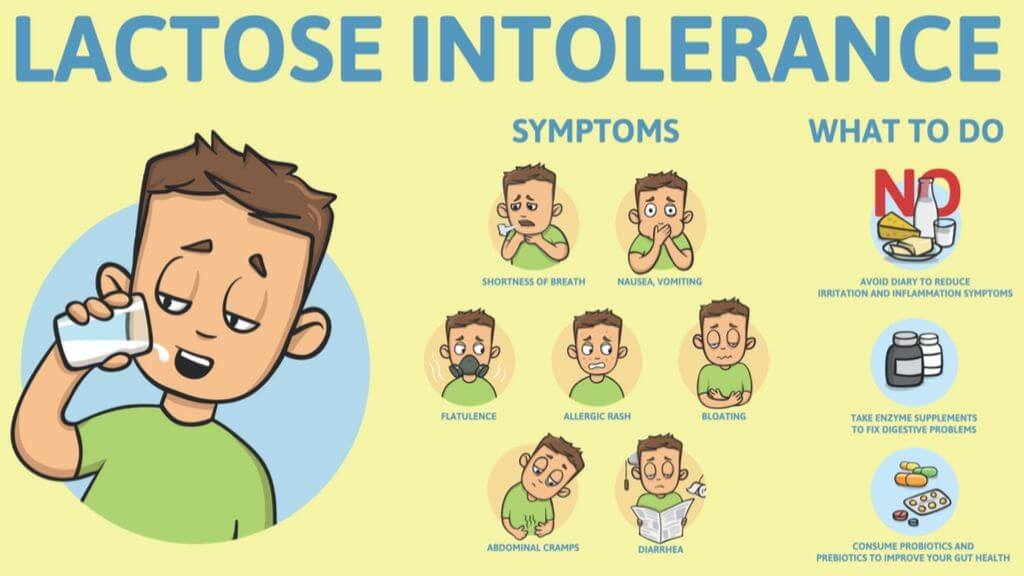Lactose intolerance is very common, with close to 75 percent of the world population being affected. Having lactose intolerance means that eating dairy foods and products causes digestive disruption and discomfort, and this can seriously impact your quality of life.
The basis of lactose intolerance is an inability to digest lactose, which is the main carbohydrate in dairy foods. Identifying it early is important for your digestive and overall health.
What Is Lactose Intolerance?
Lactose is a disaccharide, which means it consists of two sugars. This carbohydrate is made of one molecule from each of the simple sugars: glucose and galactose.
Lactase is the enzyme required to break lactose down into these sugars so that they can be absorbed and used for energy. People with lactose intolerance do not produce enough of this enzyme.
The inability for your body to digest lactose causes varied symptoms, most related to your digestive system.
Lactose Intolerance Symptoms
When managed properly, the symptoms of lactose intolerance can be significantly reduced. When not managed properly, this intolerance can cause serious digestive troubles. The most common signs of lactose intolerance include:
♦ Abdominal cramps: The inability to properly digest and breakdown lactose causes inflammation along the digestive tract, and this leads to cramping and pain.
♦ Bloating and gas: When lactose reaches your colon, it is fermented by bacteria, which forms short-chain fatty acids along with gas and bloating.
♦ Diarrhea: this occurs as undigested lactose reaches your small intestine causing water to be drawn into the digestive tract.
♦ Fat in the stool: When your body does not make enough enzymes to properly digest foods, fat ends up in your stool. This is also a sign of malabsorption, which can occur with food intolerance of any kind.
Some people also experience vomiting, lower belly pain, nausea, and the urgency to go to the bathroom. The symptoms you experience depends on the severity of your intolerance.
Causes of Lactose Intolerance
There are two main types of lactose intolerance, and each has its cause. Primary lactose intolerance is the more common type, and it is caused by reduced lactase production that is common with aging. This type can be caused by genetics.
Secondary lactose intolerance is rare and is caused by illnesses such as stomach bacteria or celiac disease. Inflammation of the gut wall from the illness causes a temporary decline in lactase production, and without this enzyme, you cannot digest lactose.
Diagnosing Lactose Intolerance
As soon as you notice the digestive symptoms associated with lactose intolerance, you should begin keeping a food diary. This will confirm if dairy foods are the culprit. You can then discuss this with your doctor, and two tests can be performed to determine if you are lactose intolerant.
1. A lactose tolerance test is usually done first to determine if you can digest lactose. After drinking lactose, your blood sugar is measured. If your blood sugar levels do not rise, then you may have lactose intolerance.
2. A hydrogen breath test will also be done as the most accurate test for lactose intolerance. On the day of the test, you will drink a liquid that contains lactose and then breathe into a machine several times over a couple of hours. Elevated levels of hydrogen on your breath indicate lactose intolerance.
Preventing Lactose Intolerance Symptoms
Lactose is found in all dairy products such as milk, cheese, ice cream, yogurt, and butter. There are also some foods that contain small amounts of dairy, and that may contain lactose. It is best to avoid these foods.
♦ Foods made with creamy sauces
♦ Cookies and baked goods
♦ Chocolate
♦ Breakfast cereals
♦ Ready-made meals
♦ Sauces and gravies
♦ Custards and other creamy desserts
Sometimes there are foods that contain lactose in more subtle ways. Added milk and dairy can often be listed under another name, making it more difficult to identify. If you have lactose intolerance, you must always check labels for these more subtle listings of dairy and lactose:
♦ Milks powder
♦ Whey and whey protein
♦ Curds
♦ Milk sugar
♦ Malted milk
♦ Sour cream
♦ Milk casein
♦ Dry milk solids
♦ Buttermilk
If you have lactose intolerance, the way to avoid uncomfortable symptoms and maintain good health is to avoid products containing lactose. The trouble with avoiding dairy is that you will also miss out on valuable nutrients.
Dairy products are high in calcium as well as vitamins A, B12, and D, which are beneficial for bone health. Dairy in the diet improves bone density and reduces your risk for breaks or bone diseases.

The good news is that all dairy foods may contain lactose, but not all of them are bad for those with lactose intolerance. Most people can tolerate small amounts, such as a splash on your morning tea or some on your cereal.
Through experimentation, you can discover just how much lactose you can handle and then adjust your diet accordingly. If you feel that all dairy needs to be avoided, then you need to speak with your doctor about getting the missed nutrients another way.
Natural Treatment for Lactose Intolerance
Lactose intolerance impairs digestion anytime that lactose is present. Chronic exposure to this sugar can cause damage to the gut through inflammation. There are several natural treatment options you can try to reduce the damage done by lactose and to provide relief from the uncomfortable symptoms.
♦ Lactobacillus rhamnosus GG: This probiotic has been proven to reduce symptoms associated with lactose intolerance as well as improve tolerance.
♦ S. boulardii: Another probiotic that prevents gut inflammation and that can treat damage caused by lactose intolerance.
♦ PreforPro: This prebiotic and enzyme combination promotes digestion and food breakdown, which can alleviate troubles digesting lactose.
♦ Bromelain: Although bromelain is responsible for digesting proteins, studies have found it to be beneficial for improving poor digestion associated with lactose intolerance.
♦ Alpha-lipoic acid (ALA): ALA is used to provide antioxidant protection for the liver. Individuals with liver disease are shown to have an increased risk of small bacterial overgrowth and lactose intolerance. ALA protects the liver from damage that can cause conditions like fatty liver disease.
What Is the Long-Term Outlook?
Lactose intolerance is something you will have for life, and it varies in severity from person to person. Some people can handle small amounts of lactose, so it is important to determine what your body can digest properly.
If ignored, lactose intolerance can cause severe digestive discomfort, and although it isn’t life-threatening, damage to your digestive tract can lead to serious disease. Avoiding dairy or adding a lactase supplement is the best way to maintain health and avoid more serious complications.
[emailcapture id="340"]








